#iron oxide poisoning
Explore tagged Tumblr posts
Text

The Science Research Diaries of S. Sunkavally, p 573.
#red tide#bone fracture#high altitude populations#cytochrome oxidase#birds#Adam's apple#audible frequencies#hydrogen atoms n the body#methyl radicals#antidote for arsenic poisoning#hydrated iron oxide#retinal damage by light#focussing of light using a magnifying glass#carbon monoxide#volcano#Beri Beri#cancer cells#folic acid#buffalo milk#sea urchin embryos
0 notes
Text
Please help Fadel afford to leave Gaza and get life-saving surgery 💔💚




Fadel @fadel-dani desperately needs to reach €10,000 and his campaign is currently only 28% funded!
The campaign is VETTED #197 on @gazavetters list

According to Fadel's blog, doctors have told him that he needs surgery by MARCH to remove iron shrapnel near his spine, or the shrapnel will begin oxidizing and poisoning his blood.
Fadel also posted yesterday (1/28) that he was hit by a car and had tendons in his foot severed by the traumatic accident.
Please, help save Fadel's life by sharing and donating anything you can. The campaign goal is only enough for Fadel to afford to leave Gaza and pay for surgery. Thank you!!
310 notes
·
View notes
Text
That won't make me more chompable -_-
Now there's a vampire outbreak... great.
#when I'm in semi-human form I could get bitten but it won't turn me into a vampire- and I bleed iron oxide so like- yeah#it could poison you#also apparently tastes like chocolate milk
175 notes
·
View notes
Text
MCSR As Chemical Compounds
idk either man. expect very little actual explanation and a lot of chemical yapping from a very big nerd
Silverr as Silver Nitrate:
AgNO3
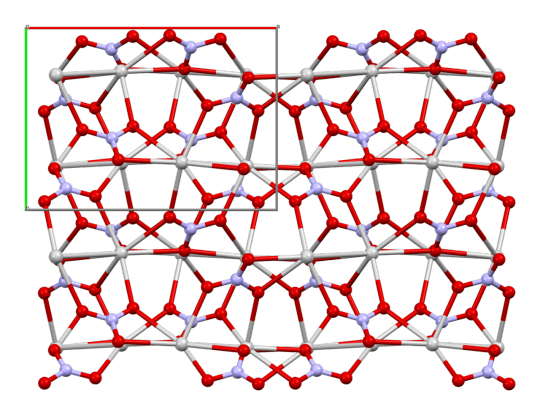
the above is the crystal structure
appearance is just a white crystal kinda like sugar
it took everything in me to not just make silverr plain Ag
silver nitrate is the most common precursor for all other important silver salts
also an extremely important compound in the development of photography! (and iirc silverr is a film major)
Feinberg as Ozone:
O3

produced during lightning strikes
pale blue at high ppm
only leaves gas state at cryogenic temperatures
naturally occurring in the stratosphere and absorbs UV rays from the sun
Fruit as Nickel(II) Chloride Hexahydrate:
NiCl2•6H2O

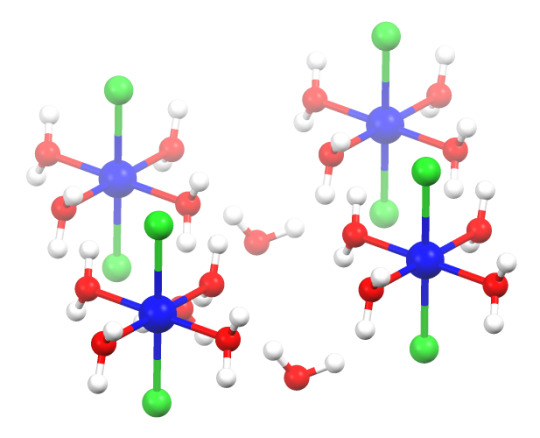
green
the non-hydrate form is a sort of olive-y yellow color
used to absorb ammonia in gas masks
Raddles as Potassium Permanganate:
KMnO4


Sometimes referred to as Purple Potion Powder
goes CRAZY purple when dissolved and is lowkey my favorite chemical
very strong oxidizing agent
one time i stained my hand purple through my glove with this shit idk how it happened
if made in specific solvents can look extremely similar to dragon's breath in minecraft imo
K4 as Octathio[8]circulene:
C16S8
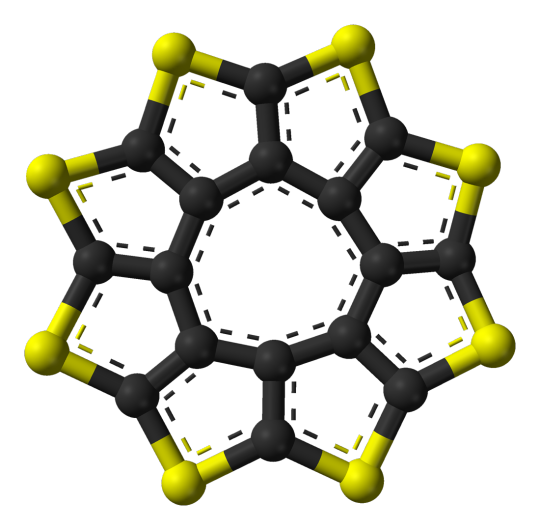
also referred to as Sulflower (like sulfur and sunflower haha get it)
planar which is fairly uncommon for molecules of this size
can be stacked together to make sheets of sulflowers
Cube as Cubane:
C8H8
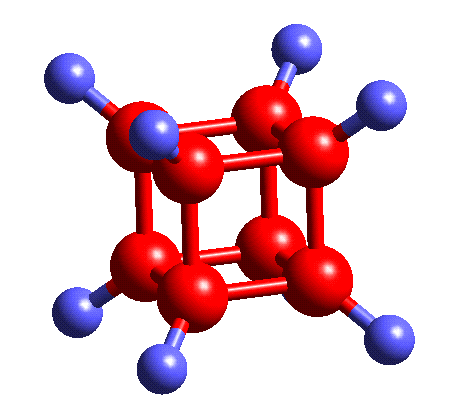
yeah this is self-explanatory
what is interesting though is that ring strain in 4 membered rings/squares is really high, so cubane existing is a bit of a chemical anomaly
i havent read into it enough to know for sure but i suspect that ring strain is why cubane is a precursor to a HELLA STRONG explosive compound
Reignex as PPTA:
Poly-p-paraphenylene terephthalamide
[-CO-C6H4-CO-NH-C6H4-NH-]n
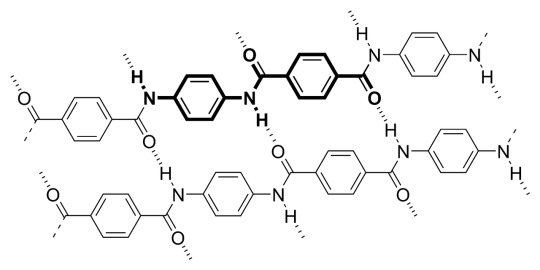
the name is complicated as shit but this is just kevlar!
aka bulletproof vest material
looks fluffy when not woven completely together
aligning of polymer chains w hydrogen bonds creates EXTREMELY high tensile strength
Mime as Phenylmagnesium Bromide:
C6H5MgBr

a common grignard reagent aka a compound that can be used in a grignard reaction, an extremely important reaction in organic synthesis as it creates new C-C bonds
another fun fact about grignard reagents is that if water is added to them- or even if they're handled in particularly moist air- they fucking explode
extremely strong nucleophile and base
Poundcake as Xenon Hexafluoride:
XeF6
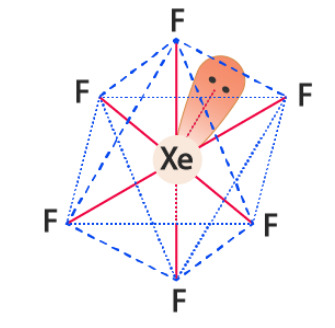
Noble gases don't react unless you REALLY make them
so a compound containing xenon is really interesting
colorless as a solid but sublimes (aka skips straight from solid to gas) into a bright yellow gas
fun fact a lot of instances where typical chemistry rules are broken (noble gases not reacting, octet rule in general, etc) involve fluorine to the point ive heard it referred to as a "batshit electron thief"
Fulham as Iron Hexacyanidoferrate:
C18Fe7N18

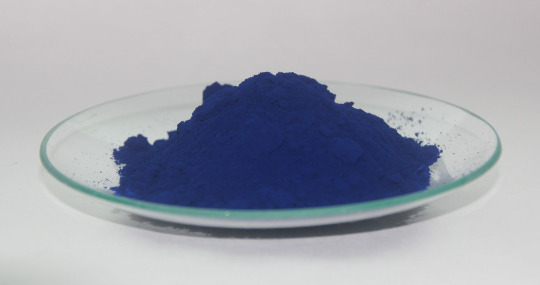
also known as prussian blue
extremely common pigment in paints and the first modern synthetic pigment
used extensively in The Great Wave
another one of my favorite molecules bc im biased and like inorganic chem aka things that contain metals
used as an antidote for heavy metal poisoning which is interesting bc it contains cyanide ligands!
Couriway as Bullvalene:
C10H10
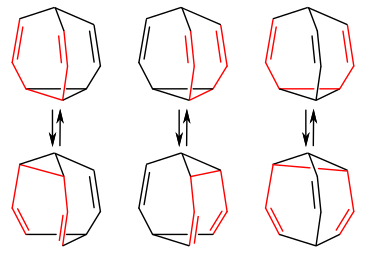
in a state of constant resonance
aka the double bonds are CONSTANTLY shifting and reforming bullvalene into... itself but moved around a little
the bonds fluctuate so rapidly that in nmr analysis each carbon and hydrogen in the entire molecule is read as equivalent (for my non-chem people that's very uncommon and very cool)
formed through photolysis (aka using light/photons to fuel a reaction)
#i made this for me and only me#chemistry is a disease and i will not be getting better anytime soon#90% of these picks are straight soul reads im gonna be so fr#mcsr#hbg#fruitberries#feinberg#couriway#fulham#president poundcake#raddles#silverrruns#reignex#talkingmime#cube1337x#k4yfour
86 notes
·
View notes
Text
Hello, this is an excerpt from my fanfic about the Akatsuki being transported into our world.
Sasori x reader
(Sorry for any possible mistakes, English is my third language.)
No warnings, it’s just something cute .
Perfumed.
Her gaze lingered on the glass display case with wooden shelves, the dim light within, the elegant bottles. She wasn’t sure why she was looking at it at all. But her body was already moving forward.
“Where are you going?” a voice sounded behind her.
Sasori.
The girl turned her head.
“I’ll be back soon. Just want to check something.”
“Of course.”
His voice carried a hint of reproach.
“I’m coming with you,” the redhead stated, stepping after her. Rena arched a thin brow.
“Why?”
“So you don’t decide to run off.”
The Akatsuki exchanged glances, silently agreeing.
“Fine,” she muttered, feeling a weight in her chest.
From the moment she crossed the threshold, the air hit her with a wave of heat—spices, or perhaps flowers? It was hard to tell, but the scent distracted her from the pounding of her heart.
Sasori took in the calm atmosphere of the shop, his gaze sweeping over the space. As the thought formed, he hesitated. After all, scent was chemistry. Composition. Just like poison.
His eyes flickered over the small glass vials on the shelf, reading the labels: amber, moss, iron oxide… He recognized these components—though from a different, more practical perspective.
“You’re staring so intently. Do you want something specific?” Rena’s voice pulled him from his thoughts.
She stood beside him, already holding a slender glass tester in her hands.
“Nothing,” he replied curtly.
For a moment, she seemed to have forgotten her worries—peace wrapped around her again. With a hopeful smile, she asked,
“Can I… give you a gift?”
She looked at him with a mix of awkwardness and curiosity.
Sasori tilted his head slightly.
“A gift?” he echoed.
Rena didn’t avert her gaze from his gray-brown eyes. From the outside, it might have seemed almost rude—intrusive.
“Why?” he asked, holding her stare, sharp as a needle.
“I… love scents. It’s my little passion. A fragrance can tell you more about a person than you might think. Perfumery is an art.”
Her voice was soft, languid, like molten beeswax.
“And what do you want to say about me? Or for me?” Sasori raised a brow slightly, the hint of a smirk playing on his lips
Rena lowered her head for a moment, curling into herself, but then, with quiet resolve, she stepped toward a display lined with tall, somber bottles.
She reached out, slowly selecting one of the testers.
“Sasori, may I see your hand?”
Akasuna stepped closer, extending his wrist. Rena applied the scent with careful precision.
Bitter smoke, something sharp, woody, with a faint sweetness. Intoxicating… No, honey and tobacco? A familiar scent.
For a fleeting second, the Scorpion’s heart stopped. He knew this smell—had heard it before, but the memory was blurred. No image, no shape—just something warm. Something close.
Rena noticed the way Sasori went still.
“Its name is Chergui by Serge Lutens,” she murmured. “A strange, complex scent. Something between decay and eternity.”
Sasori lifted his gaze in silence.
For a rare moment, emotion flickered through the face of the living puppet.
“Yes,” he admitted. “It is art.”
#sasori x reader#sasori#akatsuki x reader#akatsuki#akatsuki fanfiction#naruto shippuden#naruto#yan sasori#yandere sasori#yandere sasori x reader#sasori akasuna#akasuna no sasori#deidara x reader#deidara
7 notes
·
View notes
Text
Roleplay Ramblings: New Elements part 2

(art by global99 on DeviantArt)
Incorporating the New Elements
So, I went over the new elements in brief last time, but let’s take a further look at them today and talk about how you can work to help implement them into your games and settings. Obviously the writers at Paizo have done the work of writing them into the Lost Omens setting already, but there’s still some legwork to be done nevertheless when running the game in First Edition. So without further ado let’s get into it!
So let’s talk metal!
Prior to Rage of the Elements, metal was, at most, just a refined subset of earth. After all, where does metal come from? You dig it out of the earth, of course.
However, that’s not what metal is like in the original Wuxing interpretation, for while metal is extracted from the earth, the act of purifying and crafting it is a heavenly act, while it is also associated with death and grief, especially appropriate given the ease at which metal can be crafted into tools of death.
This isn’t to say that metal and earth have no connection, far from it. In fact, this association is explained in lore because Ayrzul the Fossilized King, the more sinister of the two lords of earth, actually broke into the realm of Laudinmio, elemental lord of metal as chemistry and and crafting, and stole from her several aspects of metal that he took and made his own, particularly poisonous and radioactive metals. The Sovereign of Alchemy was so upset about how her gifts were used she fell into an angst-coma where she remains unto this day, hopefully with someone snapping her out of it soon.
In any case, neither traditional elementalism nor Wuxing fully encompass what metal is as an element in the context of Pathfinder. So let’s explore those aspects. There is the Wall, which reflects metal’s density and strength; the Blade, which evokes it’s capacity for dealing death; the Conduit, which reflects metal’s ability to channel all manner of energies through itself, and the Spoke, representing how it can be shaped so readily into all manner of shapes, be they simple tools or the most complex mechanisms.
However, there is also an aspect of death and finality to metal beyond the sharpness of a sword or the velocity of a bullet, and that is for all it’s wondrous creations and their durability, they cannot last forever. Whether it be by oxidation, corrosion, or simply the stresses of time and repeated use, all metal eventually breaks down. Sometimes the remains can be salvaged to create new wonders, and sometimes it is beyond all but the most omniponent mages and deities to recover. Either way, even being nearly infinite, the plane of metal will one day succumb to entropy and rust, and be little more than a wasteland. But that is so far off into the future that even the Starfinder setting will be a distant memory by then.
All said, Metal is the element of creativity, strength, and inevitability, for wonders arise and wonders fall, and every moment before the end it worth experiencing, and who knows, maybe something else will rise up later?
As far as environments go, the plane of metal is pretty much exactly what you’d expect, landscapes made up almost exclusively of metallic elements with little non-metallic elements to go around. Forests of twisting silver crystals, mountains of iron, seas of quicksilver and glaciers of gallium barely holding their solidity, all of which is contained within the inside surface of a functionally infinite metal sphere. You’ll even find more mechanical environments in the places where civilized elementals live, forged from the world around them, as well as deserts of rust as things are slowly broken down by time and the careful guidance of the elementals that rule over that specific aspect.
Speaking of which, metal elementals typically embody two different poles of metal in aspects, either embodying the specific properties of metals, such as the liquid mercurial and zuhra genies, the magnetic and electical powers of pelogoxes and living lodestones, or even the quasi-supernatural properties of skymetals and other exotic fantasy metals with the likes of the skymetal strikers or abysium horrors. Meanwhile, on the other end of the spectrum are the elementals of metal as it breaks down, like rust scarabs, nanoshard swarms, oregorgers, and even the massive ramshackle melomachs. Among the most influential are the elemental lords, Laudinmio, whom we already mentioned, and Ferrumnestra, the Lady of Rust, who rules over and guides the decay of metal and makes room for the new when things have outlived their purpose.This list is hardly comprehensive, but there’s a lot of clever ideas that go into them.
Meanwhile, let’s take a look over at wood!
In Wuxing, wood is not just trees, but also covers air itself, which is a pretty impressive connection to make in a time before people understood exactly what oxygen was or the role that plant life has in the ecology of the entire planet. However, wood is also associated with growth, as well as frustration and anger, but also more positive emotions like kindness and generosity. It’s an element that feels a lot, which makes sense that it’s the one element that is made out of living material.
Of course, the idea of wood being an element is incompatible with western elementalism as they typically see living things, all living things, as being made up of elements, not being one themselves and certainly not existing by drawing upon other elements. To western elementalism, if something has to draw upon three whole other elements to even exist (earth for nutrients, water and air for important chemical processes), then it can’t be an element.
Not so with Wuxing, in which all the elements feed into each other, propping one up while undermining others, which makes wood make more sense in that context.
But what is Wood in Pathfinder? Simply put, it is verdant growth and potential cultivated by wisdom and discipline. Plants are grown and planted deliberately, trimmed back when they would crowd out other plants, and the very environment is shaped and carved, as are many of it’s denizens, from the living wood, always taking care not to needlessly kill even as homes are carved from trees on a truly colossal scale. Which isn’t to say that it lacks danger, for though discipline remains a core part of the plane, so does strong emotion, leading to plenty of furious or dangerously passionate creatures that might turn violent attention onto neighbors and visitors alike.
When I say that the Plane of Wood is cultivated order, I don’t just mean that the denizens put some effort into keeping their neck of the woods clean and pretty. I mean it’s a fundamental part of the plane. The whole plane is fractal in nature. While in theory the bottom border of the plane sinks it’s roots into the waters of the Plane of Water, everything is plants growing on plants all the way down and all the way up, from planet-sized trees with contienent size trees to country sized tress and you can see where I’m going with this. While these plants often don’t literally resemble the plants on the next largest tier but in miniature, they can, and it all keeps going down, potentially infinitely, but like all planes, perhaps not literally. As such, one can walk across a vast field which is just a mile-thick fungal mat stretched between two colossal branches, or walk around a massive tree city where streets and roads have been carved from the “dead” wood of the tree, leaving the living layer mostly untouched to keep growing and thriving. Seasons and time of day are partially determined by region and the bioluminescence of colossal plants a truly unfathomable distance above or below oneself. For that matter, in addition to plant matter familiar to denizens of Golarion, there are examples of plant life from potentially every planet across the universe as well as exotic fare that can only really exist on this plane. Of course, some environments are more hostile than others, such as the fungal denizens of the Nightwood or the areas suffering from the blight caused by Ayrzul (yes, him again. Turns out he’s pretty much an asshole to everyone).
And speaking of which, let’s talk denizens. Now some may wonder aloud what makes a wood elemental from your garden-variety plant monster, and the answers a little complex, but it boils down to how cultivation defines them. On the one hand, sure, some wood elementals are essentially mobile fruit or plant creatures such as moss sloths, pine pangolins, or harvest regiments, but others are shaped by careful cultivation, such as living groves, which the art of which expressly references the daisugi technique of Japanese logging, applying bonsai techniques to full-size trees to create perfectly straight logs. Others, however, are carved or grown into shape, such as carved beasts, painted stags, snapdrakes, or event the mighty twins of rowan, all of which are carved into shape from otherwise immobile wood (often with a still rooted base) and breathed new life into them by the rituals of either the Kizidhar genies or Shumunue, the Carved Lady of Mimicry herself, who represents wood as an art medium which imitates life as well as the ways that plant life draws in animals as pollinators or occasionally prey. Meanwhile, her counterpart is Verilorn, Custodian of Oak and Ash who presides over all agriculture, cultivation, and forestry. The two once worked together, but have grown apart in the eons of the planes isolation, to the pain of both.
And so now that we know all this about these two planes, we can actually get to the point of this entry and talk about integrating them within the pre-Second Edition setting and your own setting!
Firstly, let me gush a little about how these two new planes, which bring the elemental planes up to a whopping 6, defying both the assumptions of Wuxing AND Western elementalism in one fell swoop (not to mention all the others) also proceed to take the same basic concept of environment (i.e., being entirely made out of their element with barely any intrusion from the other elements barring those mixed-element outliers) and elevating it. Even without the illustrations from Rage of the Elements book, you can imagine an infinite fractal forest or a vast curved plane of gleaming metal and find that beautiful and awe-inspiring, and heck, they did a decent job of elevating the concept of the original 4 as well for that matter.
With that focus on elements returning and mixing, it’s also worth noting that not only are these new elements mixing with the old ones as they regrow into their old positions, but in their absence the other planes mixed as well. While it will take countless eons for them to be re-slotted in, no doubt also outstripping the cosmic era of Starfinder, eventually air and water will be mostly cut off from each other as will water and earth, but those vast areas of air-cooled ice and churning mud will never really go away.
But how will this affect your games? Well obviously if you never touch on it, it won’t, but if your 1e games want to touch on the elemental planes either directly or indirectly, it will. For the Lost Omens setting, perhaps metal and wood elementalists are gaining more respect and recognition outside of Tian Xia as anything more than a novelty, and maybe in the face of having two new pairs of elemental lords that don’t share the presumed dichotomy of good and evil will make planar scholars rethink the effects of how mortal assumptions about aspects of certain elements actually shaped the behavior of the beings that ruled them.
In a more general setting sense, having metal and wood be elements in your setting may change the sorts of environments your characters might encounter beyond the borders of the map. If they find a place where the element of wood is strong, they might think they stumbled onto some remote noble’s garden with how orderly it is until something like plants growing plants clues them into it being not quite natural, or maybe dwarves and other miners in your setting try to cultivate an elemental nexus of metal to turn a location into a motherlode of ore and valuable metals, and so on.
I’ve talked a lot about the new elemental planes in this one, but trust me, it’s all going to be very useful for the next two entries, and I hope you’re excited to see where that takes us tomorrow, starting with how character options change in a 6-element system!
18 notes
·
View notes
Text
The Toxic Sludge That Ate Tennessee (New York Times)
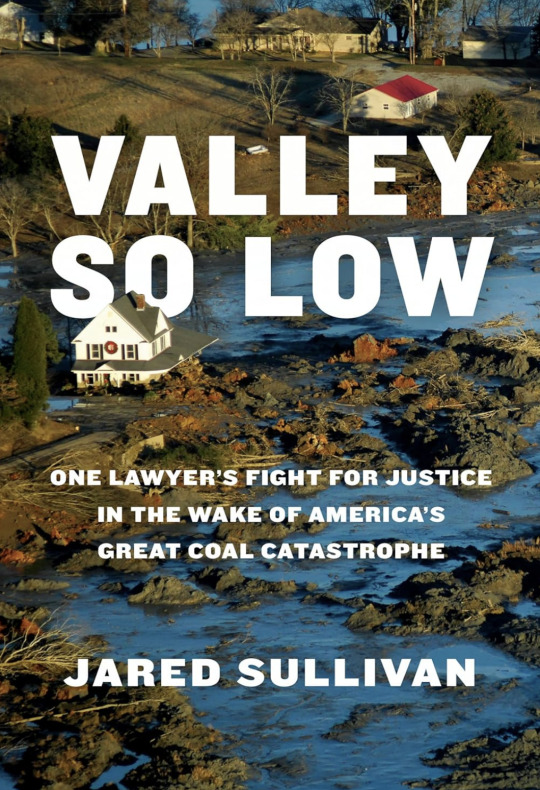
Excerpt from review of the book, "Valley So Low" by Jared Sullivan in the New York Times:
A concise summary of Jared Sullivan’s “Valley So Low” is offered halfway through the book by its hero, Jim Scott, a plain-talking, suspender-wearing, Skittles-addicted plaintiff’s lawyer: “They had a toxic tub of goop, and it blew up.”
“They” are the Tennessee Valley Authority, the nation’s largest public utility. The “goop” is coal ash, the residual soot after coal is burned for electricity. Soot might not sound so bad (one pictures a burned-out campfire). But this coal ash contained arsenic, iron oxide, aluminum oxide, selenium, cadmium, boron and thallium, what Scott called “a Long Island iced tea of poison.” As for the “tub” …
The tub began as a spring-fed swimming hole. It stood near the site of the T.V.A.’s Kingston Fossil Plant, which, when it was completed in 1954, was the world’s largest coal-fired power station. Every day the plant burned enough coal to power 700,000 homes and produce a thousand tons of ash. The T.V.A. dumped much of that ash into the swimming hole. Over decades there rose from that pond, like a zombie crawling from a tomb, an ashy colossus. It broadened into a mountain range of coal slurry, sprawling across 84 acres — until, on the morning of Dec. 22, 2008, it collapsed.
A 50-foot-high tsunami of poisonous sludge buried docks and homes and soccer fields beneath mounds of coal ash as high as six feet. By volume, it was the largest industrial disaster in U.S. history, a hundred times the scale of the Exxon Valdez oil spill. But for years most of its victims believed themselves unharmed.
Anyone with a passing knowledge of Chernobyl, Deepwater Horizon or the World Trade Center cleanup will not be surprised by what happened next. The T.V.A. announced that exposure to the ash did not pose a “significant” health concern, but nevertheless barred journalists, lawyers, environmental groups and scientists from visiting the site. Workers were warned, under threat of termination, against wearing dust masks and hazmat suits, lest local residents grow alarmed.
One safety officer told his charges that they could eat a pound of ash a day and “be fine.” Incriminating air-monitoring data was ignored, manipulated or tossed out. Before long the workers, and the wives and mothers who cleaned their clothing, began feeling dizzy, having nosebleeds and coughing up “strange black jelly.” Later they discovered that the Kingston ash was not merely toxic. It was radioactive.
There is a grinding predictability to stories of industrial disaster, particularly when it comes to the behavior of the institutions responsible. Jared Sullivan, in his scrupulous account of the aftermath of the Kingston disaster, had not only to dramatize a convoluted series of abstruse, drawn-out legal cases. He also had to contend with his villains’ shameless lack of originality. The T.V.A. and the firm it hired to clean up its mess, Jacobs Engineering, played their assigned roles with great dedication. Nearly every strategic decision they made, Sullivan suggests, seemed calculated to be “cartoonishly wicked.”
While T.V.A. spokespeople urged the public to remain calm and downplayed the extent of the spill, internal communications revealed an institution adrift in confusion and incompetence. “This is unbelievable,” one employee says, despite decades of warnings. “We did not expect this.” The T.V.A. hired white-shoe law firms to force costly trials, refusing settlements and pursuing every delay tactic possible while the plaintiffs began to die off. Meanwhile, the T.V.A.’s chief executive — at one point the nation’s highest-paid federal employee — gave a speech declaring, “We’re going to clean it up, we’re going to clean it up right.”
6 notes
·
View notes
Text

Almost every man and woman in the world is suffering from some sort of anemia in one-way or another, especially those with black blood. The medical industry gives us iron oxide in tablets (the rock form of iron) when we should be consuming iron fluorine (the plant form of iron). Iron is the mineral that conveys oxygen to the body and most importantly the brain. Iron should have carbon, hydrogen and oxygen (the CHO chain found in things containing life). Iron is the spark plug of the human body. When you are deficient in iron, you are susceptible to a whole bunch of diseases. Iron fires the body up and is the only mineral on the planet that is magnetic. Being that iron is magnetic it has a tendency to pull other minerals to it. It pulls magnesium, calcium, potassium, zinc, gold, phosphorous, etc. When you consume large quantities of iron you are taking all the other minerals in proportion. The lack of iron causes over 20 diseases to manifest. Without iron, the body looses energy and the immune system begins to give way. There is no oxygen going to the brain when iron is low. Without iron, we wrinkle at a young age and become unable to walk with a straight back. The body naturally uses the amount of 3 tablespoons of iron a day. Top up your iron daily and cut out unnatural foods. The cure is of no use if you are also taking the poison. Here are some more iron rich herbs. Some are very hard to find.
Cayenne
Cancansa
Guaco
Cardo Santo
Contribo
Hombre Gandre
Bugleweed
Governadora
Yellowdock root
Cocomeca Bark
Ortiga
Prickly Pear
Nopal
Cherries
Maya
Watercress
Fonio
Dates
8 notes
·
View notes
Text
Fist bump to @chaudskis from someone else working in cleanup.
People ARE cleaning this shit up! Lots of people. It's long and slow and maybe more exciting to say no one's doing anything. And there are all sorts of contaminated sites where no one is doing anything yet, because there are bigger fish to fry.
Using it to make paints is a neat way to bring attention to cleanup work! Gamblin isn't cleaning up, though; it's using a byproduct.
The other thing to remember is that the dose makes the poison. Some things are hella toxic in very small quantities. Iron oxides aren't. They're a problem because you've got a shit-ton dissolved in highly acidic water; the pH causes problems, the oxides settling out can smother stuff because there's just so much, and other more dangerous metals can be in there too — but iron oxides on their own make a very safe art supply. The world's oldest, in fact — the ochres!
If you're into oils, you can buy the paints and not worry. About half my oil paints are Gamblin; they make nice stuff! Given that these are earth colors, I'd expect them to behave like ochres/umbers in oils; they'll dry more quickly than the brighter artificial colors. For safety, thin with Gamsol/high-quality-oderless-mineral-spirits, but rinse between colors with walnut oil instead of solvent. I switched to this last time I oil painted and it worked great. If you use these colors the sludge on the bottom doesn't have to be treated as toxic, but a whole lot of other colors do (the danger colors are beautiful).
So what this paint company does is take iron pollution from abandoned mines that are polluting soils and rivers and makes iron based red pigment paints out of it.
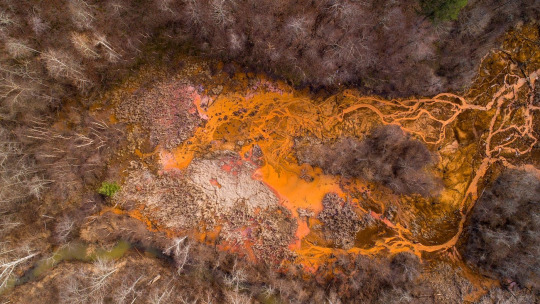
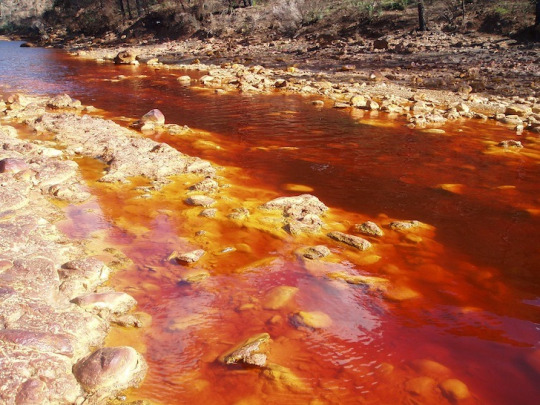
Basically they realized hey no one's cleaning this shit up, it's polluting the streams, killing all the fish, making the water undrinkable and there's a huge market for it so why not make money by cleaning it the fuck up?
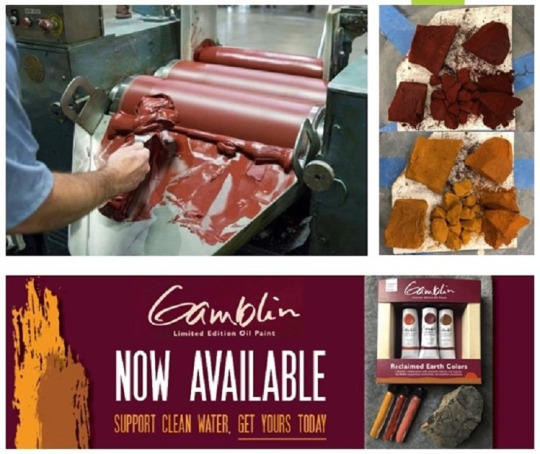
They remove this stuff by the industrial bucket load from the rivers. The idea is if it's in a painting, if it's in your home, it's not poisoning wildlife.
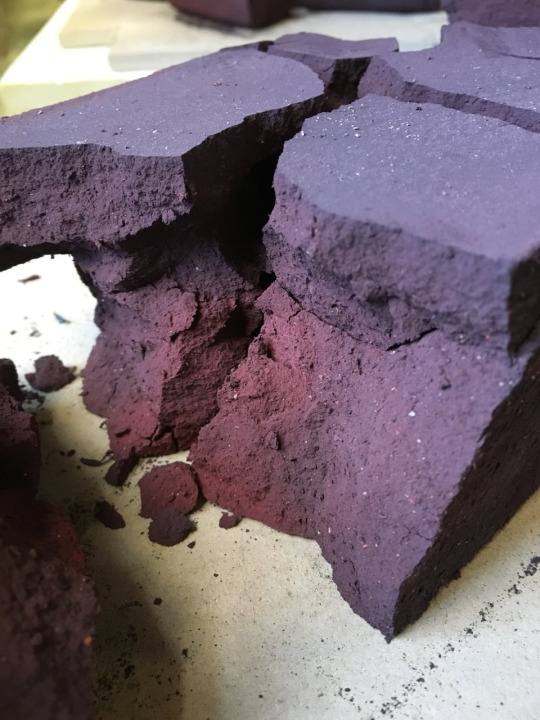

anyway its cool as shit, please support tf out of these people https://gamblinstore.com/reclaimed-earth-colors-set/
#environmental cleanup#toxic cleanup#abandoned mine program#art supplies#oil painting#pigments#the intersection of two of my worlds#I love it#When we get new site managers I test their sense of humor#by talking about the beautiful danger colors leaking out of mines#(not these but like HELLA COPPER or cobalt or cadmium)#and/or by claiming that growing up in Tacoma gave me a natural immunity to lead and arsenic#Do they laugh or get concerned?#I suppose if I'd had more childhood lead exposure I might believe that was how it worked#...imagine how smart I'd be if I hadn't had any :(
72K notes
·
View notes
Text
in my spare time, I help my bf out with lancer, specifically in solar system lore. I was quite late into the campaign, but i provided basic ass information about the system in the fictional world
before you ask- yes most of them are named after nordic gods because they sound cool to me
---
!!Planetary System!!
Vascan - the terrestrial planet closest to its host star, it's melting itself apart, due to being near the suns roche limit. There is no chance of even approaching this molten rocky planet. Scientists suggest that this planet will collapse and crumble around its star, like a ring tidally locked
Heimdall - a similar sized terresrial planet to Vascan. Mostly containing carbon and lava pools. Also extremely radioactive. Do not approach this planet. It is the brightest planet in the night sky. tidally locked
Tyr - A reddish orange terrestrial planet. Desolate, a poisonous wasteland with unforgiving blistering winds, temperatures range between 280-376C. Theoretically a former habitable planet. What information we have on this planet is covered in caverns and steep, jagged mountains.
Azure - Habitable planet. Avg temp 13C Freyr- Another habitable planet, a sister planet to Azure. Mostly green and covered in luscious green forests. Avg temp -2C
Hel- A frozen rocky planet, covered in a thick blanket of ice, but could contain liquid water underneath its surface. Avg temp -100c
Njord- Water world, surprisingly. Njord may have an active core, which keeps the water liquid. Methane and sulfur has been found in it's atmosphere. Has a moon or two. We don't know
Vidar- Recently discovered terrestrial planet. Was previously thought to be a moon of Forseti until recent discoveries. Inhabitable. Frozen, whistling winds of up to 50mps. There is no hope of landing on this planet. It keeps itself hidden for the most part.
Forseti- Uranus sized gas giant, grayish blue planet consisting of copper oxide, helium and hydrogen, there is so surface
Magni- Saturn sized gas giant, orange and and yellow planet, hydrogen, helium, iron, ammonia and sulfuric atmosphere, no surface
Hodr- Dark blue, almost black neptune sized gas giant, the blue being stripes, similar gaseous properties as neptune, just add ice :3
planetary order Vascan - Heimdall - Tyr - Azure - Freyr - Hel - Njord - Vidar - Forseti - Magni - Hodr
The host star is a yellow dwarf, much like Sol
#ash rambles#ash rambles: but abt space stuff#im trying to be a helpful bf#fictional solar system lore ig
0 notes
Text
New strain of Covid-19
From Parasitologist Jelena Borisovna Katashova
The mechanism of Covid-19!
🔸 The virus does NOT cause pneumonia! Pneumonia can be seen on an X-ray! Changes in the case of Covid-19 are visible only on a CT scan, as they are a type of lung burn! 🔸 The virus causes multi-organ pathology! It attacks all organs simultaneously – the brain, spinal cord, kidneys, liver! 🔸 This virus acts like a poison! It breaks down hemoglobin, splitting it into Fe2+ iron ions and heme (a simple protein molecule). There’s no oxygen to bind! Moreover, free iron is toxic! During the virus's attack, this process occurs in all organs simultaneously. No matter how much air the lungs fill with, the body cannot extract oxygen from it! 🔸 Blood oxygen levels will be extremely low; in the liver, enzymatic processes and toxin neutralization will be inhibited, and in the kidneys, toxin elimination will be disrupted. Toxicosis, blood viscosity, and clot formation rapidly increase in the bloodstream. 🔸 In the lungs, under the influence of active atomic iron, a type of tissue burn occurs, causing the release of inflammatory factors and hyaluronic acid.
That’s why artificial lung ventilation is often ineffective! The body quickly deals with the virus itself, but tissue burns take a long time to heal, creating scar tissue and fibrotic connections not only in the lungs. 🔸 Later, infections from chronic inflammation sources (e.g., caries, periodontitis, cholecystitis, tonsillitis, etc.) activate in the damaged tissues, eventually leading to pneumonia!
📍 That’s the nature of this virus!
What to do? 😳 It’s better not to get sick or to recover in a mild form!
Knowing how the disease progresses, the most important thing is: 💧 Healthy and clean blood, liver, and kidneys! Detoxification is everything! Detox will remove toxins, activate enzymes, and help the body overcome oxygen deprivation.
💧 Blood fluidity is crucial! Drink at least 40 ml of water per 1 kg of weight per day! 💧 Only with Coral-Mine water! Drink in small portions throughout the day. Coral-Mine gives water a balanced pH level, surface tension, and a negative charge for proper blood ion exchange processes.
🌱 H-500 will reduce oxidation and toxicosis. This preparation with atomic hydrogen will neutralize inflammation factors. 🌱 Phytoviron – 15 ml, 2–3 times a day. 🌱 Zinc – has a direct blood-strengthening effect. 🌱 Antiviral effects are provided by pau d’arco bark, licorice, and cat’s claw.
📍 If you couldn’t avoid the illness? 📍 If you know you’ve been in contact and the first symptoms appear:
🔸 Take H-500 – 10 capsules in a glass of warm water in the morning and evening. 🔸 Assimilator – 1–2 capsules every 2 hours. 🔸 Pentokan – 1 tablet 3–4 times a day. 🔸 Pau d’arco bark – 5–8 capsules 3–4 times a day. 🔸 Pour boiling water over licorice, let it steep, and drink it while still warm 3–4 times a day. 🔸 Drink water – 70–80 ml per 1 kg of weight! Even if you don’t feel like it, drink water “through reluctance,” as the virus causes a dislike for water. It dehydrates the body, leading to thrombosis at any age!
❗️ Thrombosis causes mortality, even in seemingly recovered stages!
Prepare your body now so that it can fight these diseases, and have your home pharmacy kit on hand.
#health & fitness#nutrition#natural healing#natural herbs#healthcare#health tips#treatment#physical health
1 note
·
View note
Text
Inputting Information to Change Movement
The hypothalamus regulates the human aging process. When the pituitary gland atrophies, the body ages rapidly. If we can rejuvenate the aging pituitary gland, we can restore the functions of the nervous, endocrine, and metabolic systems, delay joint and organ aging, and ultimately realize the dream of reversing aging and living forever. The atrophy of the pituitary gland is related to the information it receives. By changing the input, we can revitalize the gland.
"When a person encounters a joyful event, their spirit brightens." A "joyful event" is just a piece of information. A person in despair who receives this information can instantly dispel suicidal thoughts and recover their spirit, even returning from the brink of death. Conversely, continuous bad news can crush a person's will and spirit, leaving them lifeless.
Food, medicine, and words are all forms of information.
A Conversation with a Sage is Worth Ten Years of Study
One conversation can be worth ten years of study. This is a way of transcending time and space. Many people spend years chasing dreams and exploring, only to have everything clarified in a few words from someone wiser. “The sea of bitterness has no bounds, turn your head to see the shore," and "searching for him thousands of times, I suddenly find him in the dim light.” This leap beyond time and space shows that while many people toil their whole lives pursuing ideals and die with regrets, others achieve success effortlessly. The difference lies in their relationship with time and space. You take ten years to accomplish something, while I complete the same task in one year—haven't I transcended nine years of time and space?
If someone meets an enlightened master—a celestial in human form—and listens to their teachings, they can transcend human limitations and enter celestial realms, transcending time and space.
Restructuring
When structure changes, the essence of life changes. The processes of growth and decay shift, and life can be revitalized, transforming decay into magic.
Restructuring means rearranging atoms. Bodily changes are essentially chemical reactions: oxygen combines with copper to form copper oxide, oxygen combines with iron to form iron oxide. People who live with pigs may become like pigs; those who live with celestials may become like human celestials. The elements entering the body determine the chemical changes that occur. Poison kills, but an elixir grants immortality. Grafting pear branches onto an apple tree produces apple-pears.
Living in the same environment with the same people, culture, and diet, or remaining in the same mindset, prevents restructuring. Life requires constant change. "A person thrives by moving; a tree dies by being transplanted." As long as there is change, there is life. "Ask the canal how it stays so clear—because it is fed by a source of living water." Injecting "living water" into a pond keeps it clear and vibrant. Otherwise, it stagnates. Constant change is, in fact, a way to transcend time and space.
Inertia is human nature, resisting change and clinging to the familiar. To restructure, we must overcome inertia.
Enhancing Vibrational Frequency
The energy released by an atomic bomb is enough to destroy an entire city. If 100 kilograms of matter were completely converted into energy, it could turn the Earth into a sea of fire. This energy comes from the vibration frequency of photons within atoms—the higher the vibration frequency, the greater the energy.
People who only act when pushed, and stay motionless otherwise, have little energy. From the holographic perspective, a butterfly flapping its wings in Alaska can cause a storm at the Cape of Good Hope. This is vibration at work—the higher the frequency, the greater the impact.
To raise our vibration frequency, we must sharpen our thinking. People who are too slow and dull find it hard to raise their frequency. Some people, when taught one thing, learn only that. Others, when taught one thing, think critically and learn several things. Some even deduce entire systems. This illustrates different vibrational frequencies.
The purpose of raising the vibration frequency is not to increase energy but to achieve a seamless and rapid transcendence of time and space. From my experiences living in the Second Home, I have found that some brothers and sisters have a high vibration frequency, embodying the saying, “Hearts resonate with each other.” They can adapt and live gracefully, freely, and effortlessly in the Home in a very short time. Holographic management is quickly realized among these individuals. Conversely, some people have a vibration frequency that is too low; despite my repeated explanations of many concepts, they still cannot grasp them. They struggle with very simple things, such as "don't interfere with others' hearts or manage others' affairs," "strive for excellence in everything," and "if others do not seek my help, I will not assist them." Such simple principles—such simple tasks! Yet they still cannot accomplish them. As a result, guiding them is exhausting, making it impossible to transcend time and space.
to be continued

0 notes
Text
What is Titanium Grade 3 Round Bar and Its Applications?

Titanium alloys have earned recognition for their great electricity, lightweight nature, and fantastic corrosion resistance, making them critical in industries that call for excessive overall performance materials. Among these, Titanium Grade 3 Round Bars are substantially used because of the precise residences that make them suitable for quite a number of vital programs. Whether you are running in aerospace, marine, or chemical industries, knowledge of the abilities of Titanium Grade 3 Round Bar, DIN 3.7055 Round Bar, and UNS R50550 Round Bar can help you make knowledgeable selections for your demands.
In this blog, we’ll delve into what Titanium Grade 3 Round Bar is, the advantages it offers, and the several range of packages wherein it is used. We’ll additionally spotlight why Piyush Steel Round Bars is a depended-on dealer for extraordinary Titanium round bars.
What is Titanium Gr.3 Round Bar?
Titanium Grade 3 (moreover called DIN 3.7055 or UNS R50550) is a commercially natural titanium alloy, great by way of the usage of its superb stability of electricity, corrosion resistance, and formability. Unlike special titanium alloys which are probably alloyed with elements like aluminum or vanadium, Titanium Grade 3 is 99.8% natural titanium, with small quantities of iron and oxygen. This purity makes it pretty proof against oxidation and corrosion, in particular in harsh environments like seawater, chemical materials, and immoderate temperatures.
The Titanium Grade 3 Round Bar is available in various sizes and is usually utilized in applications wherein high strength, corrosion resistance, and lightweight material are required. It is a brilliant product for important applications in quite a few industries because of its actual weldability and superb resistance to pitting, crevice corrosion, and strain corrosion cracking.
Key Properties of Titanium Grade 3 Round Bar
Corrosion Resistance: Titanium Grade 3 is one of the maximum corrosion-resistant substances available. It performs excellently in environments exposed to chlorides, acids, and other competitive chemical substances, making it best for marine, chemical, and pharmaceutical applications.
High Strength-to-Weight Ratio: Titanium is a mainly ideal material in sectors like aerospace, where each strength and weight are essential, as it has a superior power-to-weight ratio to many unique metals.
Biocompatibility: Titanium is an excellent product for medical implants and devices due to the fact it's far believed to be non-poisonous and biocompatible.
Excellent Weldability: Titanium Grade 3 has proper weldability, allowing it to be without problems produced in specific styles and sizes, unlike different titanium alloys that call for unique welding tactics.
Temperature Resistance: Titanium Grade 3 is appropriate for programs related to slight temperatures, consisting of energy era and aerospace because it continues its structural integrity even at extended temperatures.
Applications of Titanium Grade 3 Round Bar
The amazing features of the Titanium Grade 3 Round Bar makes it ideal for a wide range of applications. Some of the most common makes use of consist of:
Aerospace and Aviation: In the aerospace organization, weight is continuously a vital factor. Titanium Grade 3 Round Bars are used inside the manufacturing of aircraft additives along with fasteners, bolts, and structural components, due to their high energy and coffee weight. Their corrosion resistance additionally guarantees that the components can face up to harsh atmospheric conditions.
Marine Applications: The marine corporation often gives tools uncovered to seawater and different corrosive environments. Titanium Grade 3 Round Bars are used inside the creation of propeller shafts, warmness exchangers, and desalination plants due to their resistance to pitting and crevice corrosion.
Chemical Processing: Titanium Grade 3 is a substitute immune to pretty some chemical substances, making it the best chemical processing tool. DIN 3.7055 Reactors, pipes, valves, and other parts that wish to withstand corrosive substances without degrading employ round bars.
Medical Applications: Titanium Gr. 3 Round Bars are widely used in orthopedic devices, dental implants, and surgical implants, among other medical devices. The biocompatibility of the products ensures that they can be utilized appropriately in the human body without causing negative side effects.
Power Generation: In power generation, Titanium Gr.3 Round Bars are applied in warm temperature exchangers, condenser tubes, and unique vital systems that require substances with excessive corrosion resistance and the capability to carry out under high-temperature conditions.
Sports Equipment: Due to its excessive power-to-weight ratio, Titanium Grade 3 is also used in excessive-forestall sports systems alongside bicycles, golfing clubs, and tennis rackets, in which overall performance and durability are key.
Automotive Industry: In the car region, Titanium Grade 3 is used for additives that require energy and corrosion resistance, which includes exhaust systems, wherein high temperatures and exposure to corrosive elements like exhaust gases are normal.
Why Choose Piyush Steel Round Bars?
At our firm, we are proud to supply incredible Titanium Grade 3 Round Bars, DIN 3.7055 Round Bars, and UNS R50550 Round Bars to meet the numerous wishes of industries throughout the globe. With our dedication to niceness, precision, and consumer delight, we've earned a reputation as a relied-on dealer of titanium products.
Quality Assurance: We use the simplest the highest grade titanium in our production strategies, making sure that every Titanium Grade 3 Round Bar meets global fantastic requirements. Our products are very well-examined for energy, durability, and corrosion resistance.
Customization: We provide custom lowering and machining offerings to meet specific client requirements. Our team works closely with customers to offer tailored solutions that fit their specific programs.
Competitive Pricing: We provide aggressive pricing on all of our titanium spherical bars, ensuring that our clients get the best value without compromising on incredible.
Global Reach: We deliver Titanium Gr.3 Round Bars to numerous industries international, which encompass aerospace, chemical processing, and scientific fields, making sure properly timed shipping and inexperienced provider to customers all through the globe.
Expert Support: Our skilled crew is generally to be had to provide technical manuals and guidance, supporting you in picking out the proper substances for your particular desires.
Conclusion
Titanium Grade 3 Round Bar is a flexible and reliable material that offers awesome corrosion resistance, electricity, and weldability. With programs spanning the duration of aerospace, marine, chemical, and scientific industries, it is a product that keeps pressuring innovation in high-ordinary overall performance sectors. If you’re searching out top class-pleasant Titanium Grade 3 Round Bars, DIN 3.7055 Round Bars, or UNS R50550 Round Bars, Piyush Steel Round Bars are your dependent associate.
Contact us nowadays for all of your titanium spherical bar requirements and enjoy the extraordinary, precision, and know-how which have made us a frontrunner in the industry.
0 notes
Text
Wood Charcoal Market Landscape: Trends, Drivers, and Forecast (2023-2032)

The Wood Charcoal Market is projected to grow from USD 21989.7 million in 2024 to an estimated USD 25363.05 million by 2032, with a compound annual growth rate (CAGR) of 1.8% from 2024 to 2032.
Wood charcoal, a traditional fuel and industrial material, is produced by the pyrolysis of wood, a process that involves heating wood in the absence of oxygen. This method decomposes the wood into charcoal, leaving behind a carbon-rich product that has been used for thousands of years as a fuel source, in metallurgy, and for various other applications. The production of wood charcoal typically involves burning hardwoods like oak, maple, or hickory, as these types of wood yield a high-quality charcoal with a dense carbon content, making it highly efficient as a fuel. One of the key characteristics of wood charcoal is its ability to burn at high temperatures while producing minimal smoke, which makes it particularly valuable for cooking and grilling. It is widely favored in barbecue culture, especially in traditional and artisanal grilling methods, where the flavor of the smoke from the wood adds a unique taste to food.
In addition to its use in cooking, wood charcoal plays a crucial role in various industrial applications. In metallurgy, for instance, charcoal is used as a reducing agent in the smelting of metals like iron. The high carbon content of wood charcoal helps in extracting metal from its ore by reducing the metal oxides to pure metal, a process that has been fundamental to metalworking for centuries. Furthermore, wood charcoal is utilized in the production of activated charcoal, a form of carbon that is processed to have a high surface area and is used extensively in filtration systems, medical applications, and environmental protection. Activated charcoal is particularly effective at adsorbing impurities from air and water, making it a critical component in water purification, air filters, and even in poison control treatments.
The wood charcoal market is driven by a variety of factors that contribute to its sustained demand across different regions and applications. Here are some of the key drivers:
1. Growing Demand for Charcoal in Cooking and Grilling:
The increasing popularity of outdoor cooking, particularly barbecuing and grilling, is a major driver of the wood charcoal market. In many cultures, especially in North America, Europe, and parts of Asia, wood charcoal is preferred for its ability to impart a unique smoky flavor to food. The rise of artisanal and gourmet cooking trends has further fueled demand for high-quality, hardwood charcoal, which is prized for its clean burn and high heat output.
2. Traditional Use in Developing Regions:
In many developing countries, particularly in Africa and parts of Asia and Latin America, wood charcoal remains a primary fuel source for cooking and heating. Its affordability, availability, and efficiency compared to other fuels like electricity or gas make it indispensable for millions of households. This sustained demand in rural and low-income areas continues to drive the market, despite efforts to transition to cleaner energy sources.
3. Industrial Applications:
Wood charcoal is extensively used in various industrial processes, especially in metallurgy, where it serves as a reducing agent in the smelting of metals like iron. Its high carbon content and ability to generate intense heat without producing a lot of smoke make it ideal for these applications. Additionally, wood charcoal is used in the production of activated carbon, which is vital in water purification, air filtration, and other environmental and medical applications. The demand for activated carbon, in particular, is growing as concerns about water and air quality increase globally.
4. Increasing Popularity of Activated Charcoal:
Activated charcoal, derived from wood charcoal, is experiencing growing demand due to its wide range of applications in health, beauty, and environmental sectors. It is used in products like water filters, air purifiers, cosmetics, and even as a detoxifying agent in food and beverages. This demand is driving the market for high-quality wood charcoal, which serves as the base material for activated carbon production.
5. Sustainability and Environmental Concerns:
While traditional charcoal production has environmental drawbacks, there is a growing movement towards sustainable practices in the industry. Consumers and businesses are increasingly seeking sustainably produced charcoal, which is made using waste wood, plantation timber, or through improved production methods that reduce emissions and conserve resources. The shift towards sustainability is creating new opportunities within the market for certified eco-friendly charcoal products.
6. Expansion of the Global Barbecue Market:
The global barbecue market is expanding, particularly in regions where grilling has become a popular social activity. The proliferation of barbecue restaurants, the growing number of barbecue competitions, and the increasing popularity of grilling at home are all contributing to the rising demand for wood charcoal. In countries like the United States, Brazil, Australia, and South Korea, barbecue culture is deeply ingrained, supporting steady market growth.
7. Urbanization and Population Growth:
As urbanization increases, particularly in developing countries, the demand for accessible and affordable cooking fuels like wood charcoal is likely to grow. Urban populations in regions with limited access to electricity or gas often rely on charcoal as a primary or supplementary fuel source, driving market demand. Additionally, population growth in these regions contributes to the overall increase in charcoal consumption.
8. Economic Factors:
The affordability of wood charcoal compared to other energy sources is a significant driver, especially in regions where income levels are low and access to modern fuels is limited. Economic downturns or fluctuations in energy prices can lead to increased reliance on charcoal as a cost-effective alternative for cooking and heating.
9. Cultural and Traditional Practices:
In many parts of the world, the use of wood charcoal is deeply rooted in cultural and traditional practices, particularly in cooking. For instance, traditional dishes and cooking methods in Africa, Asia, and Latin America often rely on charcoal for the distinctive flavors it imparts. These cultural practices ensure a continued demand for wood charcoal, even as alternative energy sources become more available.
10. Regulatory Environment and Policy Support:
In some regions, governments are promoting sustainable charcoal production through policy support, subsidies, and incentives for eco-friendly practices. This support helps drive the market by encouraging producers to adopt sustainable methods, which can also meet the growing consumer demand for environmentally responsible products.
Key Player Analysis:
BandB Charcoal
Cooks International LLC
Duraflame Inc.
Fire & Flavor Grilling Company
Fogo Charcoal
Greencoal Namibia CC
Hans Enterprises
P.BIOCOAL
Kamodo Joe
Kingsford Products Company
Royal Oak Company
Saint Louis Charcoal Company
Southern Fuelwood
The Charcoal Supply Company
The Clorox Company
The Original Charcoal Company
Two Trees Products
More About Report- https://www.credenceresearch.com/report/wood-charcoal-market
The wood charcoal market exhibits significant regional variations driven by differences in cultural practices, industrial applications, economic conditions, and environmental policies. Here’s a breakdown of the regional insights for the wood charcoal market:
1. Africa:
Dominance of Charcoal as a Primary Fuel: In Africa, wood charcoal is a critical source of energy, particularly for cooking and heating in rural and urban households. In countries like Nigeria, Kenya, Tanzania, and the Democratic Republic of Congo, a large portion of the population relies on charcoal due to the limited access to electricity and other modern fuels. The demand for wood charcoal in Africa is sustained by its affordability and availability, despite environmental concerns associated with deforestation and inefficient production methods.
Environmental Impact and Sustainability Efforts: The widespread use of charcoal in Africa has led to significant deforestation, prompting efforts by governments and NGOs to promote sustainable charcoal production practices. Initiatives include the development of more efficient charcoal kilns, reforestation programs, and the promotion of alternative fuels to reduce the environmental impact.
2. Asia-Pacific:
Diverse Market Dynamics: The Asia-Pacific region has diverse market dynamics with significant demand for wood charcoal in both domestic and industrial applications. Countries like Indonesia, Vietnam, and the Philippines are major producers of wood charcoal, often exporting to other regions. In rural areas of Southeast Asia and South Asia, charcoal remains an important cooking fuel.
Export-Oriented Production: Indonesia, in particular, is one of the largest exporters of wood charcoal, with substantial production driven by both domestic use and international demand, particularly from countries in the Middle East and Europe. The region's vast tropical forests provide abundant raw materials for charcoal production, although sustainability remains a concern.
Growing Demand for Activated Charcoal: The demand for activated charcoal, particularly in India, China, and Japan, is driving the market. Activated charcoal is used in various applications, including water purification, air filtration, and cosmetics, contributing to the growth of the wood charcoal market in this region.
3. North America:
High Demand for Barbecue Charcoal: In North America, particularly in the United States and Canada, wood charcoal is widely used for outdoor cooking and barbecuing. The market is characterized by a strong preference for high-quality, artisanal charcoal made from hardwoods like oak and hickory, which provide superior heat and flavor for grilling. The popularity of barbecue culture, coupled with seasonal demand peaks during summer, drives the market.
Sustainability and Eco-Friendly Products: There is a growing consumer preference for sustainably produced charcoal, with an increasing demand for products that are certified as eco-friendly or made from renewable resources. Companies in North America are responding to this trend by offering sustainably sourced and produced charcoal products, often highlighting their environmental credentials as a key selling point.
4. Europe:
Demand Driven by Barbecue and Industrial Use: In Europe, the demand for wood charcoal is driven by both consumer and industrial applications. Barbecuing is popular in countries like Germany, France, and the United Kingdom, where consumers seek high-quality charcoal for outdoor cooking. Additionally, wood charcoal is used in industrial processes, particularly in the production of activated carbon and in metallurgy.
Environmental Regulations: Europe is at the forefront of environmental sustainability, with strict regulations governing charcoal production and trade. The European Union has implemented policies that encourage sustainable forest management and the use of eco-friendly production methods. As a result, there is a growing market for certified sustainable charcoal products, which comply with environmental standards and appeal to environmentally conscious consumers.
5. Latin America:
Significant Production and Export: Latin America, particularly Brazil, is a major producer and exporter of wood charcoal. Brazil’s vast forests provide ample resources for charcoal production, much of which is exported to other regions, including Europe and the Middle East. The country’s charcoal is used both domestically and internationally, with significant applications in the steel industry and in barbecue cultures.
Sustainability Challenges: The charcoal industry in Latin America faces challenges related to deforestation and environmental degradation. In response, there are ongoing efforts to promote sustainable charcoal production practices, including the use of plantation-grown timber and the implementation of more efficient production technologies to reduce environmental impact.
6. Middle East:
Import-Driven Market: The Middle East is a significant consumer of wood charcoal, particularly for traditional cooking methods and shisha (hookah) use. Countries in the region, including Saudi Arabia, the UAE, and Egypt, import large quantities of charcoal, primarily from Africa and Southeast Asia, to meet domestic demand.
Cultural Significance: In the Middle East, the use of charcoal is deeply embedded in cultural practices, especially in food preparation and social gatherings involving shisha. This cultural significance ensures steady demand, with consumers favoring high-quality, long-burning charcoal for both cooking and recreational purposes.
7. Global Trends:
Shift Towards Sustainability: Across all regions, there is a noticeable shift towards more sustainable production and consumption of wood charcoal. Consumers are increasingly aware of the environmental impact of traditional charcoal production, leading to greater demand for sustainably sourced and produced charcoal. This trend is prompting producers to adopt certification schemes, improve production efficiency, and explore alternative raw materials to reduce environmental impact.
Segmentation:
By Product Type
Lump charcoal,
Briquettes,
Charcoal powder.
By Wood Type
Hardwood,
Softwood,
By Application
Residential,
Commercial,
Industrial applications.
By End-Use
Food preparation,
Metallurgy,
Chemical production.
Browse the full report – https://www.credenceresearch.com/report/wood-charcoal-market
Browse Our Blog: https://www.linkedin.com/pulse/wood-charcoal-market-report-opportunities-ikhcf
Contact Us:
Phone: +91 6232 49 3207
Email: [email protected]
Website: https://www.credenceresearch.com
0 notes
Text
For those interested to know, the reason why these love locks are bad is because people tend to drop or toss the keys into the canyon. Condors, especially young ones just leaving the nest, are very curious and love shiny things (most desert animals do because shiny = water) and consequently tend to swallow the keys. Best case these keys cause irritation and they regurgitate them before they pass into the gizzard, but unfortunately a lot of keys are coated in bronze or plastic and therefore don’t cause an immediate sense of discomfort. When the keys get to the gizzard, the rough shape causes ulcers and in some cases poisoning; zinc is to birds what lead is to us, and quite a lot of keys are anodized with zinc alloy to prevent oxidation, ironically.
Also, big horned sheep and deer will also swallow the keys, because they’re cold in the mouth and taste good. Metallic minerals are quite rare in the herbivorous diet so they tend generically to like licking or chewing on metals, which is why mineral blocks are a thing.
The locks themselves can cause damage too; they heat up exponentially faster than the surrounding rock, which if there’s brush nearby can cause a fire. Heat seeking animals like reptiles can also burn themselves, being drawn to the early morning heat. What’s more, where there are a lot of these locks, they create a nice warm area where reptiles such as rattlesnakes like to hang out at dawn, when tourism is the heaviest.
So yeah. No more locks in the canyon.
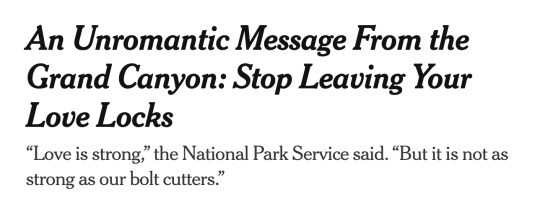
49K notes
·
View notes
Text
Let's be clear – I'm about as granola as a Big Mac. Yeah, I've jumped out of perfectly good aeroplanes and arsed around foreign countries on my own, but that just makes me an adrenaline junkie with a passport, not some hemp-wearing spiritual guru. I'll even munch those dried earthworms you can get off the internet because apparently I've got the dietary preferences of a deranged bird. But at least my parents let me have ice cream for dinner, which is basically what peak parenting looks like in my book.
So there I am, living my best fucking life, when this news story drops like a bomb made of pure what-the-actual-fuck. Turns out these fancy makeup brands we've all been throwing money at have been secretly including a side order of asbestos with their overpriced face paint. You know, that lovely little mineral that gives you mesothelioma – the cancer that basically turns your lungs into a horror show that makes Saw look like CBeebies.
Now we've got women dropping like flies and suing these beauty bastards because apparently slapping on some Estée Lauder bronzer was basically the same as licking a construction site from the 1970s. Makes you wonder if the makeup industry's secretly run by a cabal of serial killers who thought poison was getting a bit passé.
Had to do a proper CSI investigation of my own makeup drawer after that. Talc is everywhere, lurking in your blush like a murderous ex-boyfriend, hiding in your eyeshadow like a serial killer in a shit horror film. Even dry shampoo isn't safe, which is basically just talc pretending to be useful. Thank fuck my usual products are clean – iron oxides and carnauba wax instead of actual death powder. And bless my mom for using non-talc baby powder on me, or I'd probably be glowing in the dark by now.
But here's the real kicker – these poncy "clean beauty" brands charging thirty quid for a lipstick are still using this death dust! They're all "Our talc is different, it's special, it's pure as the driven snow and definitely won't turn your organs into tumour factories." Right, and I'm the Queen of fucking Sheba. Can't wait for some scientist to stick that "pure" talc under an electron microscope in twenty years when we're all wearing wigs and looking like extras from The Walking Dead.
The most mental part is how easily avoided this whole shitshow could be. Corn starch does the same job without the whole "slowly killing you" bit, but I suppose that's not profitable enough for these corporate cunts. It's like Big Tobacco all over again, except instead of targeting teenagers with cool packaging, they're targeting women with the promise of looking less dead while actually making us more dead.
All I want is to put on some bloody makeup without wondering if it's going to Hannibal Lecter my internal organs, is that too much to ask? If we've managed to ban things like lead paint and asbestos insulation, surely we can get rid of talc before it turns the entire beauty industry into one massive class action lawsuit waiting to happen. I've inhaled enough potentially carcinogenic powder for one lifetime, thanks very much. At this rate, I might as well just rub coal dust on my face – at least then I'd know what was killing me.
0 notes